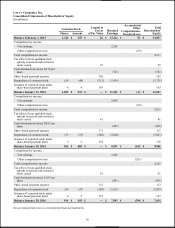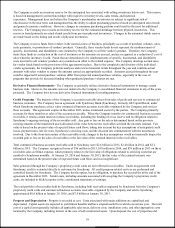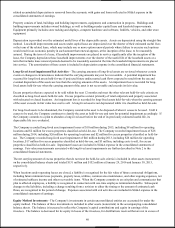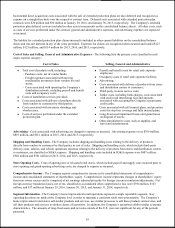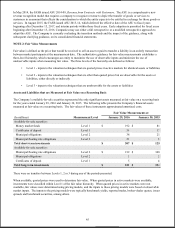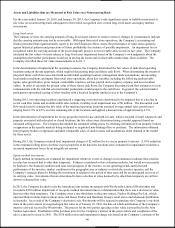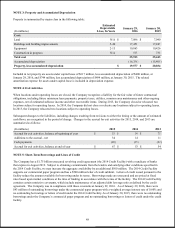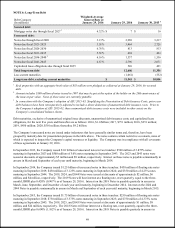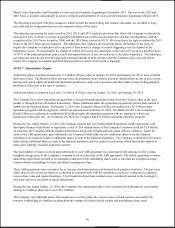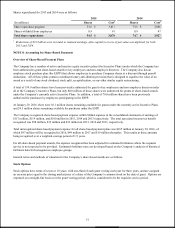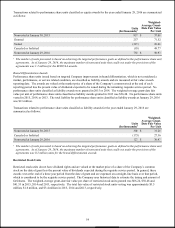Lowe's 2015 Annual Report Download - page 55
Download and view the complete annual report
Please find page 55 of the 2015 Lowe's annual report below. You can navigate through the pages in the report by either clicking on the pages listed below, or by using the keyword search tool below to find specific information within the annual report.
46
Assets and Liabilities that are Measured at Fair Value on a Nonrecurring Basis
For the years ended January 29, 2016, and January 30, 2015, the Company’s only significant assets or liabilities measured at
fair value on a nonrecurring basis subsequent to their initial recognition were certain long-lived assets and equity method
investments.
Long-lived assets
The Company reviews the carrying amounts of long-lived assets whenever certain events or changes in circumstances indicate
that the carrying amounts may not be recoverable. With input from retail store operations, the Company’s accounting and
finance personnel that organizationally report to the chief financial officer, assess the performance of retail stores quarterly
against historical patterns and projections of future profitability for evidence of possible impairment. An impairment loss is
recognized when the carrying amount of the asset (disposal) group is not recoverable and exceeds its fair value. The Company
estimated the fair values of assets subject to long-lived asset impairment based on the Company’s own judgments about the
assumptions that market participants would use in pricing the assets and on observable market data, when available. The
Company classified these fair value measurements as Level 3.
In the determination of impairment for operating locations, the Company determined the fair values of individual operating
locations using an income approach, which required discounting projected future cash flows. When determining the stream of
projected future cash flows associated with an individual operating location, management made assumptions, incorporating
local market conditions and inputs from retail store operations, about key variables including the following unobservable
inputs: sales growth rates, gross margin, controllable expenses, such as payroll and occupancy expense, and asset residual
values. In order to calculate the present value of those future cash flows, the Company discounted cash flow estimates at a rate
commensurate with the risk that selected market participants would assign to the cash flows. In general, the selected market
participants represented a group of other retailers with a location footprint similar in size to the Company’s.
During 2015, two operating locations experienced a triggering event and were determined to be impaired due to a decline in
recent cash flow trends and an unfavorable sales outlook, resulting in an impairment loss of $8 million. The discounted cash
flow model used to estimate the fair value of the impaired operating locations assumed average annual sales growth rates
ranging from 3.9% to 4.3% over the remaining life of the locations and applied a discount rate of approximately 6.3%.
In the determination of impairment for excess properties held-for-use and held-for-sale, which consisted of retail outparcels and
property associated with relocated or closed locations, the fair values were determined using a market approach based on
estimated selling prices. The Company determined the estimated selling prices by obtaining information from property brokers
or appraisers in the specific markets being evaluated or negotiated non-binding offers to purchase. The information obtained
from property brokers or appraisers included comparable sales of similar assets and assumptions about demand in the market
for these assets.
During 2015, the Company incurred total impairment charges of $2 million for six excess property locations. A 10% reduction
in the estimated selling prices for these excess properties at the dates the locations were evaluated for impairment would have
increased impairment losses by an insignificant amount.
Equity method investments
Equity method investments are evaluated for impairment whenever events or changes in circumstances indicate that a decline
in value has occurred that is other than temporary. Evidence considered in this evaluation includes, but would not necessarily
be limited to, the financial condition and near-term prospects of the investee, recent operating trends and forecasted
performance of the investee, market conditions in the geographic area or industry in which the investee operates, and the
Company’s strategic plans for holding the investment in relation to the period of time expected for an anticipated recovery of
its carrying value. Investments that are determined to have a decline in value deemed to be other than temporary are written
down to estimated fair value.
In 2015, the Company decided to exit the Australian joint venture investment with Woolworths Limited (Woolworths) and
recorded a $530 million impairment of its equity method investment due to a determination that there was a decrease in value
that was other than temporary. The Company owns a one-third share in the joint venture, Hydrox Holdings Pty Ltd., which
operates Masters Home Improvement stores and Home Timber and Hardware Group’s retail stores and wholesale distribution
in Australia. As a result of the Company’s decision to exit, Woolworths will be required to purchase the Company’s one-third
share in the joint venture at an agreed upon fair value as of January 18, 2016, the date on which notification of the Company’s
intent to exit was received by Woolworths. The process for the two parties agreeing on fair value is prescribed in the Joint
Venture Agreement. Finalization of the purchase price for the Company’s interest in the joint venture and completion of the
sale is expected to occur in 2016. The $530 million non-cash impairment charge was based on the Company’s estimate of the


